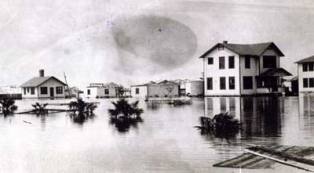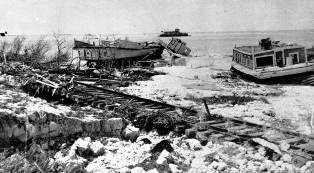Discover Florida Nature
It's time to explore the natural Florida


|
|
|
|
|
|
The List of Florida hurricanes encompasses approximately 486 tropical or
subtropical cyclones that affected the state of Florida. More storms hit
Florida than any other U.S. state, and since 1851 only eighteen
hurricane seasons passed without a known storm impacting the state.
Collectively, cyclones caused a death toll of 10,272 people in the
region, most of which occurring prior to the start of Hurricane Hunters
flights in 1943. Additionally, the cumulative impact from the storms
totaled over $115 billion in damage (2008 USD), primarily from Hurricane
Andrew and hurricanes in the 2004 and 2005 seasons. Tropical cyclones have affected Florida in every month of the year but January and March. Nearly one-third of the cyclones affected the state in September, and nearly three-fourths of the storms affected the state between August and October, which coincides with the peak of the hurricane season. Portions of the coastline have the lowest return period, or the frequency at which a certain intensity or category of hurricane can be expected within 86 mi (139 km) of a given location, in the country. Monroe County was struck by 54 hurricanes since 1926, which is the greatest total for any county in the United States. The strongest tropical cyclone to make landfall on the state was the Labor Day Hurricane of 1862, which crossed the Florida Keys with a pressure of 892 mbar; it is also the strongest hurricane on record to strike the United States. Out of the ten most intense land falling United States hurricanes, four struck Florida at peak strength! The first recorded tropical cyclone to affect the area that is now the state of Florida occurred in 1523, when two ships and their crews were lost along the western coastline. A total 159 hurricanes are known to have affected the state prior to 1900, which collectively resulted in at least 6,504 fatalities and monetary damage of over $90 million (2008 USD). Additionally, at least 109 boats or ships were either driven ashore, wrecked, or damaged due to the storms. Information is sparse for earlier years due to limitations in tropical cyclone observation, though as coastlines became more populated, more data became available. The National Hurricane Center recognizes the uncertainty in both the death tolls and the dates of the events. In the period between 1900 and 1949, 108 tropical cyclones affected the state, which collectively resulted in about $4 billion (2008 USD) in damage. Additionally, tropical cyclones in Florida were directly responsible for about 3,500 fatalities during the period, most of which from the 1928 Okeechobee Hurricane. The 1947 season was the year with the most tropical cyclones affecting the state, with a total of 6 systems. The 1905, 1908, 1913, 1927, 1931, 1942, and 1943 seasons were the only years during the period in which a storm did not affect the state. The strongest hurricane to hit the state during the period was the Labor Day Hurricane of 1935, which is the strongest hurricane on record to strike the United States. Several other major hurricanes struck the state during the period, including the 1926 Miami Hurricane, the 1928 Okeechobee Hurricane, and a cyclone each in 1945 and 1949 which made landfall as a Category 4 hurricane.  1928
Okeechobee Hurricane-Coastal damage in Florida near the point
of landfall was catastrophic. Northward, from Pompano Beach to Jupiter,
buildings suffered serious damage from the heavy winds and 10 ft (3 m)
storm surge, which was heaviest in the vicinity of Palm Beach; total
coastal damages were estimated as "several million" dollars. In West
Palm Beach, more than 1,711 homes were destroyed, while the Jupiter
Inlet Lighthouse's mortar was reportedly "squeezed ...like toothpaste"
between the bricks during the storm, swaying the tower seventeen inches
off the base. Because of well-issued hurricane warnings, residents were
prepared for the storm, and the number of lives lost in the coastal
Palm Beach area was only 26. But inland, along Lake Okeechobee, few
conceived the disaster that was brewing. The storm hit Florida with 125
mph winds. Forty miles west of the coast, rain filled Lake Okeechobee to
the brim and the dikes crumbled. Water rushed onto the swampy farmland,
and homes and people were swept away. Almost 2,000 people perished. The
resulting flood covered an area of hundreds of square miles with water
that in some places was over 20 ft (6 m) deep. Houses were floated off
of their foundations and dashed to pieces against any obstacle they
encountered. Most survivors and bodies were washed out into the
Everglades where many of the bodies were never found. As the rear
eyewall passed over the area, the flood reversed itself, breaking the
dikes along the northern coast of the lake and causing a similar but
smaller flood. 1928
Okeechobee Hurricane-Coastal damage in Florida near the point
of landfall was catastrophic. Northward, from Pompano Beach to Jupiter,
buildings suffered serious damage from the heavy winds and 10 ft (3 m)
storm surge, which was heaviest in the vicinity of Palm Beach; total
coastal damages were estimated as "several million" dollars. In West
Palm Beach, more than 1,711 homes were destroyed, while the Jupiter
Inlet Lighthouse's mortar was reportedly "squeezed ...like toothpaste"
between the bricks during the storm, swaying the tower seventeen inches
off the base. Because of well-issued hurricane warnings, residents were
prepared for the storm, and the number of lives lost in the coastal
Palm Beach area was only 26. But inland, along Lake Okeechobee, few
conceived the disaster that was brewing. The storm hit Florida with 125
mph winds. Forty miles west of the coast, rain filled Lake Okeechobee to
the brim and the dikes crumbled. Water rushed onto the swampy farmland,
and homes and people were swept away. Almost 2,000 people perished. The
resulting flood covered an area of hundreds of square miles with water
that in some places was over 20 ft (6 m) deep. Houses were floated off
of their foundations and dashed to pieces against any obstacle they
encountered. Most survivors and bodies were washed out into the
Everglades where many of the bodies were never found. As the rear
eyewall passed over the area, the flood reversed itself, breaking the
dikes along the northern coast of the lake and causing a similar but
smaller flood. Labor
Day Hurricane of 1935- the Labor Day Hurricane of 1935 was the
first ever Category Five Hurricane on record to hit the United States.
The compact and intense hurricane caused extreme damage in the upper
Florida Keys, as a storm surge of approximately 18 to 20 feet affected
the region. The hurricane's strong winds destroyed most of the buildings
in the Islamorada area, and many World War I veteran workers were killed
by the storm surge. Portions of the Key West Extension of the Florida
East Coast Railroad were severely damaged or destroyed. The evacuation
train, which left Homestead was filled with veterans and 100s of other
locals from the keys came to a sudden halt. When it reached the
Islamorada water tank the 10 cars were tossed off the track and over on
their sides by powerful waves that were now surging over the islands.
The engine alone remained on its wheels, but it ceased to move because
the fire in the box was out. The hurricane also caused additional damage
in northwest Florida, Georgia, and the Carolinas. In total, more than
400 people were killed. Labor
Day Hurricane of 1935- the Labor Day Hurricane of 1935 was the
first ever Category Five Hurricane on record to hit the United States.
The compact and intense hurricane caused extreme damage in the upper
Florida Keys, as a storm surge of approximately 18 to 20 feet affected
the region. The hurricane's strong winds destroyed most of the buildings
in the Islamorada area, and many World War I veteran workers were killed
by the storm surge. Portions of the Key West Extension of the Florida
East Coast Railroad were severely damaged or destroyed. The evacuation
train, which left Homestead was filled with veterans and 100s of other
locals from the keys came to a sudden halt. When it reached the
Islamorada water tank the 10 cars were tossed off the track and over on
their sides by powerful waves that were now surging over the islands.
The engine alone remained on its wheels, but it ceased to move because
the fire in the box was out. The hurricane also caused additional damage
in northwest Florida, Georgia, and the Carolinas. In total, more than
400 people were killed.
|
|
|
Advertise | Privacy Statement | Dog Encyclopedia | Video |Contact | Alaska Nature |
|